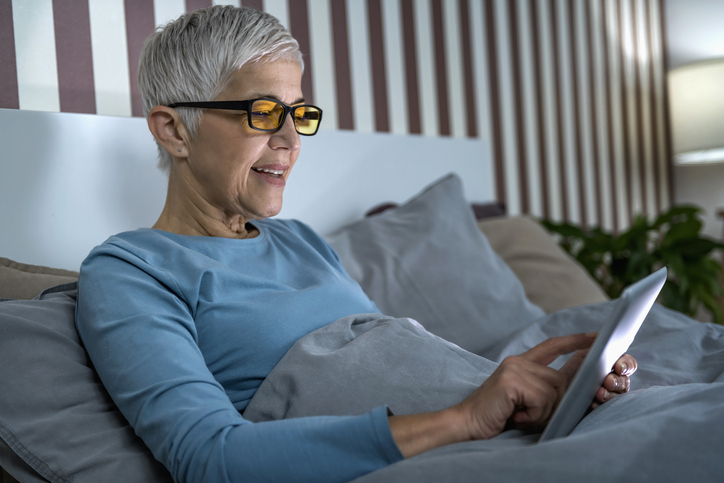In a world where screens are an integral part of daily life, concerns about blue light and its effects on eye health are more prevalent than ever. For tech users, separating fact from fiction is crucial to making informed decisions about screen use and eye care. This blog post dives into the myths and truths about blue light, providing practical advice for minimising potential harm.

Introduction
Understanding blue light and its sources is the first step toward debunking common misconceptions. Blue light is everywhere, emanating from the sun as well as artificial sources like digital screens and LED lighting. But how does it really affect our health?
The Truth About Blue Light and Eye Health
Insights on Blue Light’s Real Impact
Contrary to alarmist claims, occasional screen use does not cause permanent eye damage. However, prolonged exposure to blue light, especially from artificial sources, may lead to digital eye strain. Symptoms include discomfort, fatigue, and difficulty focusing.
Differentiating Between Natural and Artificial Blue Light
Natural blue light from the sun helps regulate our sleep-wake cycle and mood. In contrast, artificial blue light from screens can disrupt this cycle, especially if used late at night. Understanding this difference is key to managing blue light exposure effectively.
Blue Light’s Role in Sleep Patterns
Sun vs. Screens
While natural blue light has beneficial effects during the day, excessive exposure to artificial blue light at night can interfere with sleep quality by suppressing melatonin production. To mitigate this, limit screen use before bedtime and consider using “night mode” settings on devices.
Practical Tips for Managing Blue Light Exposure at Night
Adopt regular screen breaks using the 20-20-20 rule (every 20 minutes, look at something 20 feet away for 20 seconds), apply screen filters, and explore blue light blocking glasses to minimise evening blue light exposure from screens.
Digital Devices and Eye Health
Research on Screen Time
Extended screen time can contribute to digital eye strain. While the blue light itself isn’t the sole culprit, it’s part of a wider issue that includes glare, blinking less often, and viewing screens at close distances.
How to Mitigate Blue Light Exposure from Screens
Making small adjustments, such as optimising screen settings for comfort, adjusting the workspace lighting to reduce glare, and ensuring screens are not too close to the eyes, can significantly reduce the risk of strain and discomfort.

Dispelling Common Myths
Advice on Reducing Screen Strain
Regular breaks, proper screen placement, and using appropriate lighting are effective ways to minimise eye strain. Blue light blocking glasses can help, but the most important actions involve reducing overall screen time and improving screen habits.
Fact-Checking Common Misconceptions About Blue Light
Myth: All blue light is harmful. Truth: Blue light has both positive and negative effects, depending on the source and timing of exposure. By managing how and when we’re exposed to blue light, especially from screens, we can enjoy the benefits without the drawbacks.
Tips for Managing Blue Light Exposure
- Use Blue Light Filters: Most digital devices offer built-in blue light filters that can adjust the screen’s colour temperature, reducing blue light exposure, especially during evening hours.
- Adjust Screen Brightness: Keeping the screen brightness in harmony with your environment can significantly reduce eye strain.
- Optimise Your Workspace Lighting: To minimise glare and reduce blue light exposure, ensure that your workspace is well-lit with indirect lighting.
- Follow the 20-20-20 Rule: Make it a habit to look away from your screen every 20 minutes at something 20 feet away for at least 20 seconds.
- Consider Blue Light Blocking Glasses: For those spending extensive hours in front of screens, blue light blocking glasses may be beneficial.
- Maintain a Healthy Distance from Screens: Ensure that screens are at an arm’s length away from your eyes and that the top of the screen is at or slightly below eye level.
The Importance of Regular Eye Checks
Beyond managing blue light exposure, scheduling regular eye examinations is crucial for maintaining overall eye health. These checks can reveal not only vision-related problems but also signs of other health issues such as diabetes and high blood pressure. Melbourne’s Optometrists can provide tailored advice on protecting your eyes from screen-related strain and recommend specific measures based on your individual eye health and lifestyle.
Conclusion
For tech users, making informed choices about digital device use and taking simple steps to mitigate potential risks are vital. Understanding the real effects of blue light and implementing practical strategies can help maintain eye health without cutting screen time completely. Remember, balance and informed decisions are key to navigating the digital world safely and healthily.
